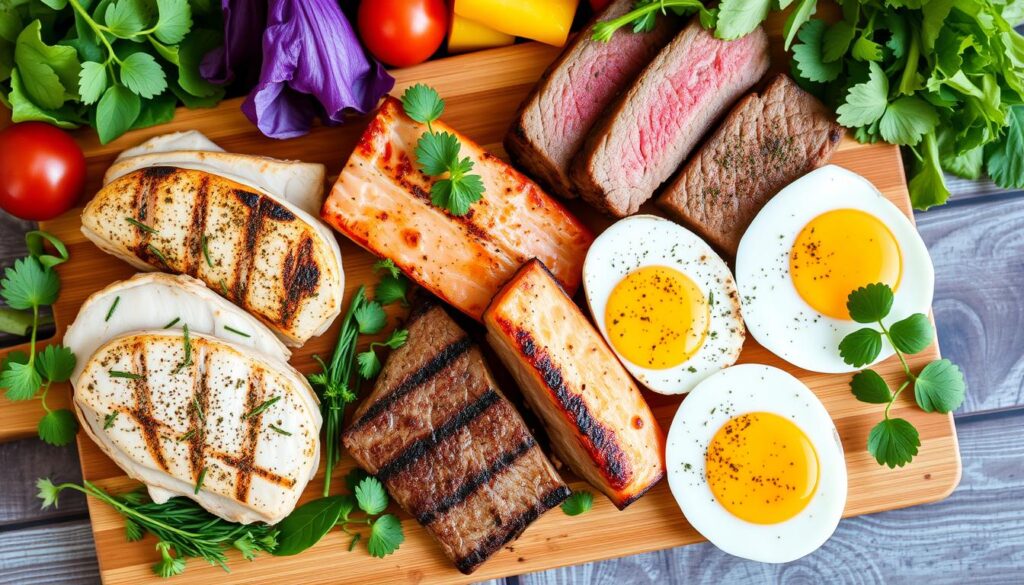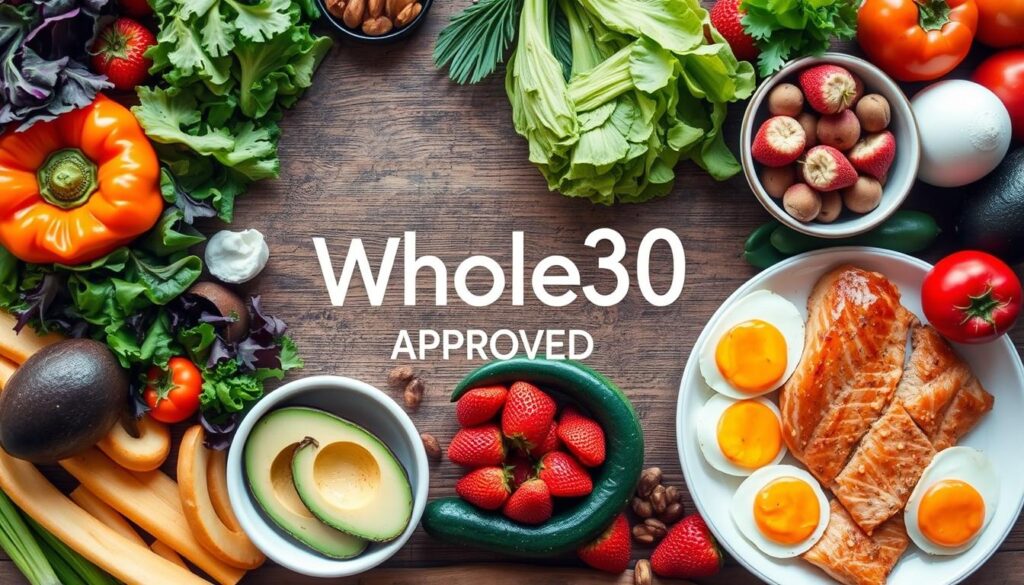The Whole30 program is a 30-day diet to reset your body. It helps improve your health. You avoid foods that cause inflammation and harm your hormones and gut.
This diet focuses on eating whole foods. You can’t eat grains, legumes, dairy, alcohol, added sugars, or processed foods for 30 days.
The goal is to find out which foods upset your body. You stop eating these foods for 30 days. Then, you slowly add them back to see how they affect you.
Knowing what you can and can’t eat is key. It helps you get the most from your 30-day reset. This way, you can enjoy the program’s benefits.
Key Takeaways
- The Whole30 diet is a 30-day elimination plan designed to reset your body and improve overall health.
- It focuses on consuming whole, unprocessed foods and eliminates grains, legumes, dairy, alcohol, added sugars, and processed foods.
- The goal is to identify problem foods that may be causing inflammation, cravings, or negatively affecting your hormones and gut health.
- Familiarizing yourself with the approved and prohibited foods is crucial for successfully navigating the Whole30 program.
- The Whole30 diet emphasizes mindful eating and encourages the consumption of nutrient-dense, whole-food options.
Understanding the Whole30 Program Basics
The Whole30 program is a short-term reset for your diet. It helps find food sensitivities and start better habits. You’ll avoid foods like sugar, grains, and dairy for 30 days.
This diet focuses on eating whole foods. It aims to make your body better and improve your health.
The 30-Day Reset Explained
The Whole30 program lasts 30 days. You stop eating certain foods and drinks. This lets your body find out if it reacts to anything.
After 30 days, you start eating those foods again. This helps see how your body reacts.
Core Principles and Goals
Whole30 teaches you to avoid sugar, grains, and dairy. You should eat lots of veggies and fruits. It also tells you to eat good fats and proteins.
The goal is to stop bad eating habits. It helps you find foods you might not be able to eat well.
Benefits of Following Whole30
Whole30 can make you feel more energetic and sleep better. It also helps with digestion and cravings. Many people lose weight and have clearer skin.
It’s about feeling good, not just losing weight. You shouldn’t weigh yourself during the 30 days.
The Whole30 diet is a 30-day clean eating plan. It focuses on eating whole, healthy foods. By avoiding bad foods, it helps you start better eating habits. This can improve your whole30 meal plan and health.
Foods to Eliminate During Whole30
The Whole30 diet is a 30-day clean eating program. It’s designed to reset your body and improve health. You’ll need to avoid certain foods and ingredients during this time.
Grains, legumes, dairy, added sugars, alcohol, and processed foods are off-limits. This means no bread, pasta, rice, beans, milk, cheese, or ice cream. You also can’t have added sugar.
Reading labels is key to success on the Whole30 diet. Look out for hidden sugars, additives, or banned ingredients. Even healthy-looking foods can have surprises.
Instead, focus on whole, unprocessed foods. This includes vegetables, fruits, meats, seafood, nuts, seeds, and healthy fats like olive oil and coconut oil.
- Vegetables
- Fruits
- High-quality meats and seafood
- Nuts and seeds
- Healthy fats like olive oil and coconut oil
By avoiding bad foods and eating clean, you’ll see many benefits. You might feel more energetic, sleep better, have improved digestion, and crave less.
“The elimination phase is crucial for resetting the body and identifying potential food sensitivities.”
Complete Whole30 Diet Food List
The Whole30 diet is all about eating whole, unprocessed foods. These foods help nourish your body. Here’s a list of proteins, veggies, fruits, and healthy fats for the 30-day program.
Proteins and Meats
Whole30 approved proteins are top-notch meats, seafood, and eggs. Choose grass-fed, pasture-raised, or wild-caught animal products. Here are some great protein options:
- Beef (100% grass-fed and grass-finished)
- Chicken (pasture-raised)
- Eggs
- Pork (pasture-raised)
- Salmon and other wild-caught seafood
- Turkey (pasture-raised)
- Whitefish
Vegetables and Fruits
Vegetables and fruits are good on the Whole30 diet. You can have all veggies except corn and lima beans. All fruits are okay too. Eat a variety of colorful produce for lots of nutrients.
Healthy Fats and Oils
Healthy fats are key in the Whole30 program. Good cooking fats and oils are:
- Avocado oil
- Coconut oil
- Extra-virgin olive oil
- Ghee or clarified butter
- Lard
- Palm oil
- Tallow
Focus on whole30 approved foods for your shopping list. This will help you succeed in the program.
Approved Proteins on Whole30
The whole30 diet food list and paleo diet focus on good, simple protein sources. On Whole30, you can eat many proteins to keep your body strong and healthy.
Some great protein choices on Whole30 are:
- Grass-fed beef
- Pasture-raised chicken and pork
- Wild-caught fish, such as salmon, tuna, and cod
- Shellfish, like shrimp, mussels, and crab
- Organic, free-range eggs
Choose meats that are grass-fed and raised well. These give you the best nutrition and follow Whole30’s clean eating rules.
Bacon can be tasty on Whole30, but pick sugar-free bacon. Look for it from Applegate, ButcherBox, or Pederson’s Natural Farms.
Eating different approved proteins can make you feel full and healthy. It helps you stay on track with your health goals.

Vegetables and Fruits Guide
The Whole30 diet is all about eating lots of veggies and fruits. These foods give you important vitamins, minerals, and fiber. They help keep you healthy and happy during the 30-day program.
Approved Vegetables
You can eat many veggies on the Whole30 diet. Leafy greens like spinach, kale, and lettuce are great. So are broccoli, cauliflower, and Brussels sprouts.
Root veggies like sweet potatoes, carrots, and beets are also good. You can have bell peppers, tomatoes, zucchini, and asparagus too.
Fruit Consumption Guidelines
All fruits are okay on the Whole30 diet, but eat them in small amounts. This is especially true if you have sugar cravings. Try berries, citrus fruits, apples, bananas, pineapple, and melons.
By eating fruits wisely, you can still enjoy sweet foods. This way, you stay on track with the Whole30 program.
“Embracing a diverse array of vegetables and fruits is key to unlocking the full benefits of the Whole30 diet. By nourishing your body with a wide range of produce, you’ll experience enhanced energy, improved digestion, and better overall health.”
Healthy Fats and Cooking Oils
The Whole30 diet focuses on healthy fats from whole foods. These fats help you feel full and absorb nutrients. They also keep you healthy while on the program. You can find many healthy fats in the Whole30 approved foods list.
Extra-virgin olive oil is a top choice for cooking on Whole30. It’s good for cooking seafood, veggies, or meats at low heat. Some studies say it might not be best at low heat, but others say it’s okay.
Avocado oil is also great for cooking. It can handle high heat, like stir-fries or searing steaks. It’s also good for making mayonnaise and other sauces that follow the Whole30 rules.
Coconut oil is another good fat for Whole30. It works well at high heat and adds flavor to dishes like curries. Ghee, or clarified butter, is also allowed. It has a high smoke point and tastes nutty.
Adding these healthy fats and oils to your meals makes them tasty and nutritious. They help keep your body healthy while on the Whole30 diet.
Nuts, Seeds, and Compliant Snacks
The Whole30 program lets you enjoy many nuts, seeds, and snacks. These foods are full of nutrients and can make you feel full. You can have crunchy almonds and cashews, savory pumpkin seeds, and tasty chia pudding.
Approved Nuts and Seeds
Here are some whole30 snacks you can have:
- Almonds
- Cashews
- Walnuts
- Macadamia nuts
- Sunflower seeds
- Pumpkin seeds
These foods are great for hunger and give you healthy fats, protein, and fiber. They keep you full and give you energy.
Smart Snacking Options
Choosing the right whole30 snacks is key. Look for foods without added sugars, grains, and other no-go ingredients. Here are some good snack ideas:
- Vegetable sticks with compliant dips (like guacamole or nut-based dips)
- Hard-boiled eggs
- A handful of mixed nuts or seeds
- Chia pudding with fresh berries
- Collard green and chicken spring rolls
- Plantain chips with cauliflower hummus
Whole30 is about eating mindfully, not out of habit. Stick to these whole30 approved foods to help your health and wellness goals.
Beverages and Condiments
The Whole30 diet focuses on whole, unprocessed foods. It helps reset the body, curb cravings, reduce inflammation, and boost energy. It has rules for drinks and condiments.
Allowed drinks include water, unsweetened sparkling water, and herbal tea without sugars or fake flavors. Black coffee and coconut water without additives are also okay. For condiments, check the labels. You can use mustard, compliant salsa, hot sauce, and certain mayonnaise. Vinegars like apple cider and balsamic, and coconut aminos are good too.
Remember, clean eating and the whole30 diet food list mean being careful with drinks and condiments. Staying with approved choices helps keep your Whole30 journey on track. It supports your health and wellness goals.
Approved Beverages
- Water
- Unsweetened sparkling water
- Herbal tea (without added sugars or artificial flavors)
- Black coffee (without sweeteners or additives)
- Coconut water (without additives)
Approved Condiments
- Mustard (without added sugars)
- Compliant salsa
- Hot sauce
- Whole30-approved mayonnaise
- Apple cider vinegar
- Balsamic vinegar
- Coconut aminos

“The Whole30 diet is a game-changer for anyone looking to improve their overall health and well-being. By sticking to the approved food list and being mindful of the beverages and condiments you consume, you can experience amazing benefits like better sleep, clearer skin, and increased energy levels.”
Shopping Tips for Whole30 Success
Going to the grocery store for Whole30 can really help you succeed. Learning to read labels and making a good shopping list are key. Let’s look at some tips to make shopping for Whole30 easy and quick.
Reading Labels Effectively
Good Whole30 shopping means reading labels well. This helps you avoid hidden sugars and bad ingredients. Try to buy whole foods without labels. Look for added sugars, artificial sweeteners, and other Whole30 no-nos on labels.
Building Your Shopping List
Having a good Whole30 shopping list is very important. Make sure it has lots of approved proteins, veggies, fruits, and healthy fats. Also, get Whole30-friendly herbs, spices, and condiments for flavor. Planning and stocking your kitchen well helps you stick to Whole30 for 30 days.
Improving your label-reading and making a smart shopping list will help you succeed on Whole30. A bit of planning makes your Whole30 journey easier and more successful.
“Meal planning and prepping can make all the difference in your Whole30 success. Take the time to build a comprehensive shopping list and you’ll be set up for greatness.”
Common Mistakes to Avoid
Starting a Whole30 journey can change your life. But, it’s key to watch out for common mistakes. With over 15 years of Whole30 experience, we’ve listed the top mistakes to avoid.
Not preparing well for the program is a big mistake. Not having the right foods or meal plans can make it hard. Also, trying to make unhealthy foods with Whole30 ingredients is not right.
Not eating enough is another mistake. Whole30 can lead to not getting enough calories. This can hurt your metabolism and health. It’s important to read labels and know how much to eat.
- Failing to plan meals and snacks in advance
- Trying to recreate unhealthy foods with compliant ingredients
- Not eating enough during the program
- Stepping on the scale or taking body measurements
- Overlooking hidden non-compliant ingredients in products
Don’t weigh yourself or take body measurements during Whole30. These actions can take away from the diet’s benefits. Benefits include better digestion, sleep, and energy.
Even a little bit of non-compliant food can mess up the diet. So, always check labels and follow the rules. By avoiding these mistakes, you can have a successful Whole30 journey.
“The key to Whole30 success is preparation, consistency, and a willingness to learn from your mistakes. Stay the course, and you’ll be amazed by the positive changes you experience.”
Conclusion
The Whole30 diet helps find food sensitivities and boosts health in 30 days. It focuses on whole foods and avoids bad ones. This can give you more energy, better digestion, and less inflammation.
But, the Whole30 diet has its limits. Experts say it might not work well for everyone. It cuts out foods that are good for you and can hurt your body.
It’s strict and you have to start over if you slip up. This can be hard for some people.
The Whole30 diet is good for improving clean eating and finding food issues. By sticking to the rules and eating more plants, you can make smart food choices. Always talk to doctors and listen to your body to make sure the Whole30 diet food list is right for you.


A Life-Changing Experience with This Weight Loss Supplement (Nagano Tonic)
I’ve always struggled with finding a weight loss solution that actually works for me. Like many, I’ve tried numerous diets, exercise routines, and supplements over the years—some worked for a short time, but nothing ever gave me long-term results. That was until I decided to try the weight loss supplement I found : Link to the Supplement.
From the moment I started using it, I noticed a difference. Not only did I feel more energized, but my cravings also became more manageable. The best part? I started seeing results much quicker than I anticipated! Over the course of just a few weeks, I noticed a significant reduction in belly fat and overall weight loss that I hadn’t been able to achieve before.
What makes this supplement stand out from all the others I’ve tried is how it supports me in my daily routine without any jitters or energy crashes. I’m able to stay focused and motivated, which has made it easier to stay on track with my diet and exercise plan.
This product truly exceeded my expectations, and I feel more confident and healthier than ever before. If you’re struggling with your weight loss journey like I was, I highly recommend giving this supplement a try. It’s been a game-changer for me, and I’m sure it can work wonders for you too!
Contant Them on email .. tonicnagano50@gmail.com
I’ve tried so many weight loss products over the years, but nothing worked like this supplement! Since I started using it, I’ve noticed a big difference in my energy levels and appetite control. In just a few weeks, I’ve lost weight and feel so much better. It’s been easy to stick with, and the results speak for themselves. Highly recommend this to anyone looking to make a real change!
wasn’t sure what to expect, but this weight loss supplement has really impressed me! After just a few weeks of use, I’ve already dropped a few pounds and feel more motivated to stay active. It’s helped curb my cravings and boosted my energy throughout the day. I’m excited to keep going and see even better results. Definitely worth trying!
Reach them on tonicnagano50@gmail.com
I was skeptical at first, but this supplement has truly made a difference in my weight loss journey. I’ve lost weight without feeling deprived or sluggish. My cravings are under control, and I feel more confident in my body. It’s easy to incorporate into my daily routine, and the results speak for themselves. I’m so glad I gave it a try!
Thanks David, i do use the link to make my purchase. you can get too here http://surl.li/iasppy
I’ve tried so many weight loss products, but this one has been by far the most effective. In just a few weeks, I’ve noticed a visible difference in my body and energy levels. It’s helped me stay on track without the constant hunger pangs and cravings. I’m really happy with my progress and can’t wait to see where I’ll be in another month!
This Nagano Tonic has been amazing! In just a few weeks, I’ve lost weight, feel more energized, and my cravings are under control. Highly recommend it!
Thats the link to purchase http://surl.li/iasppy